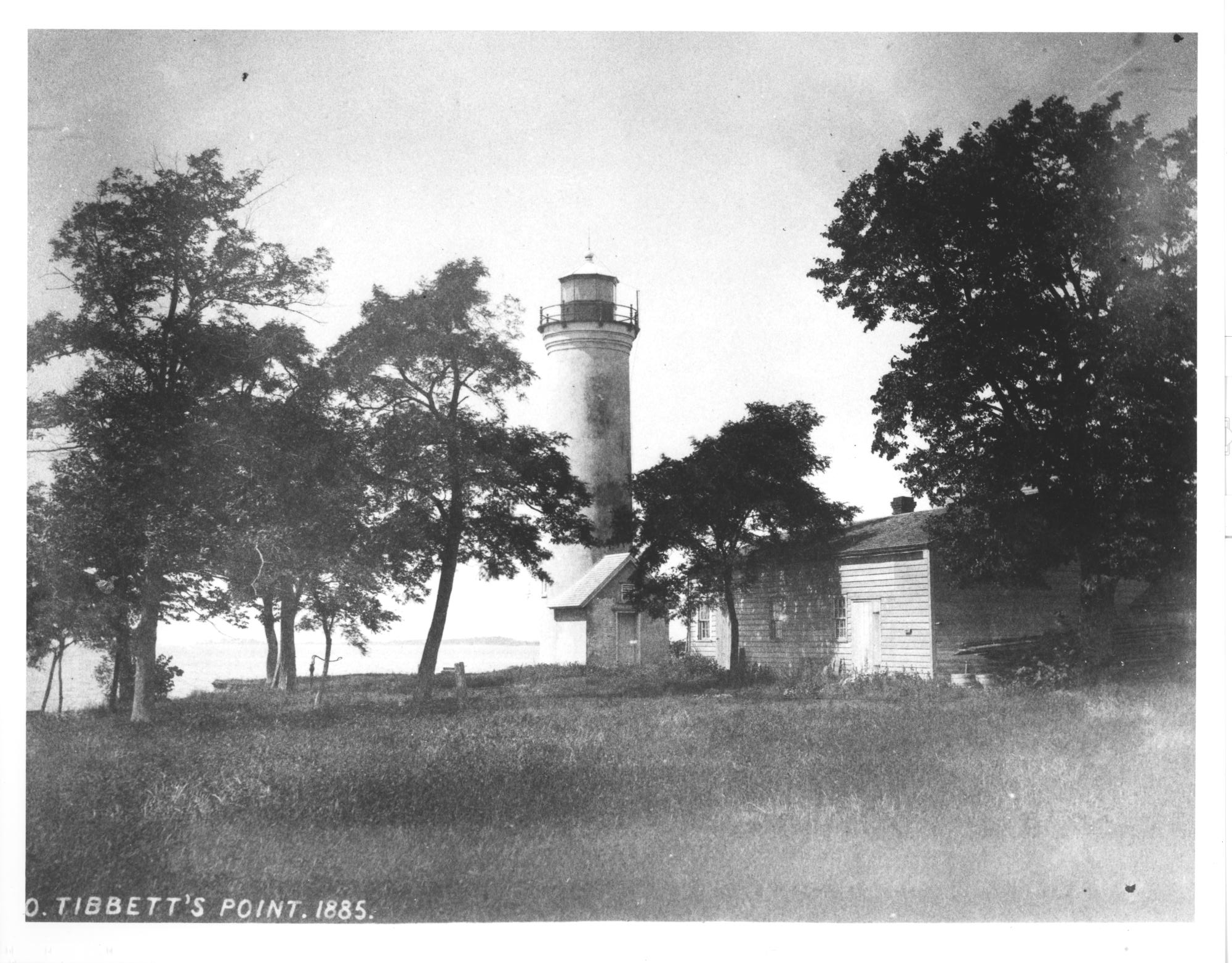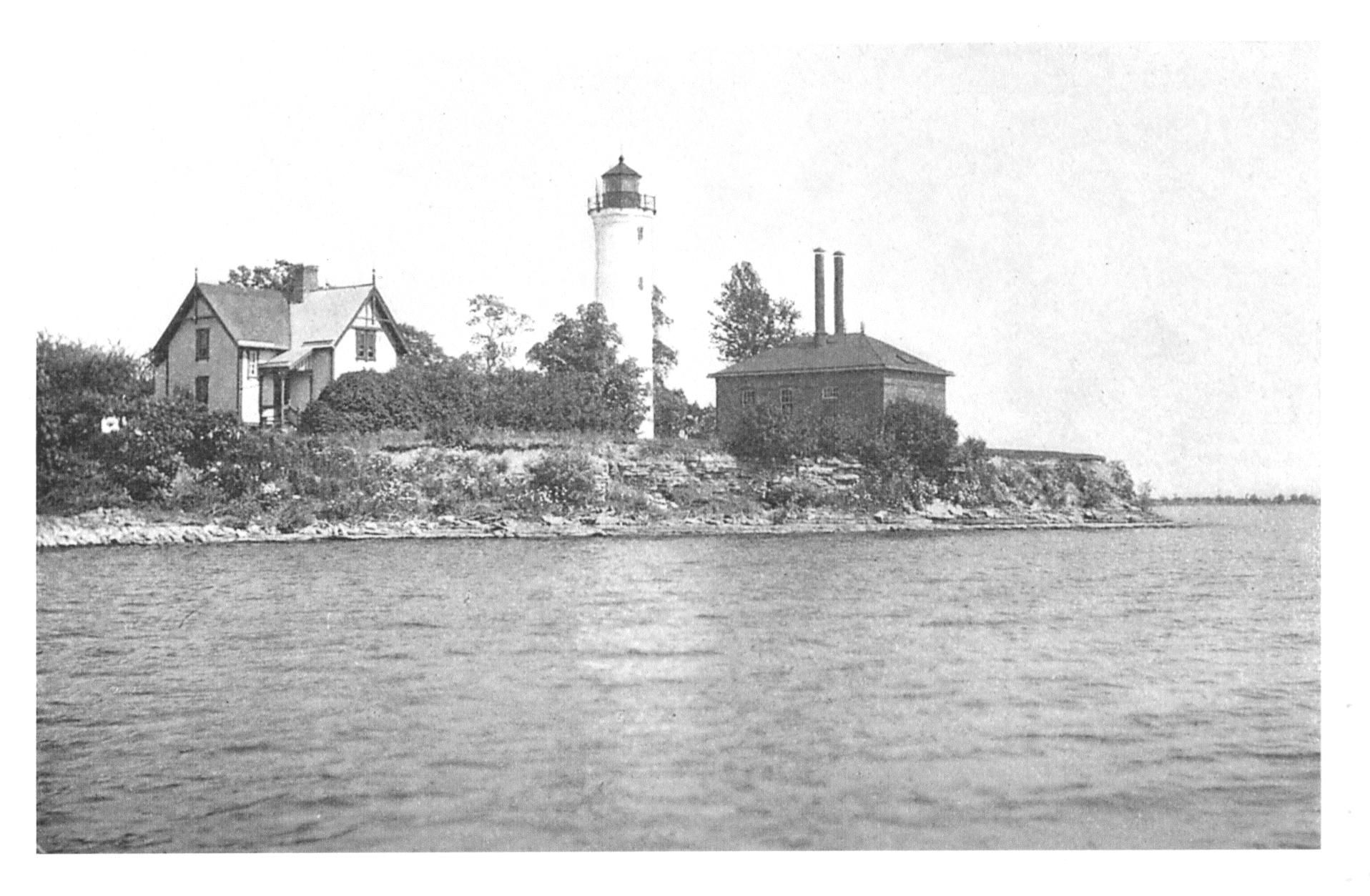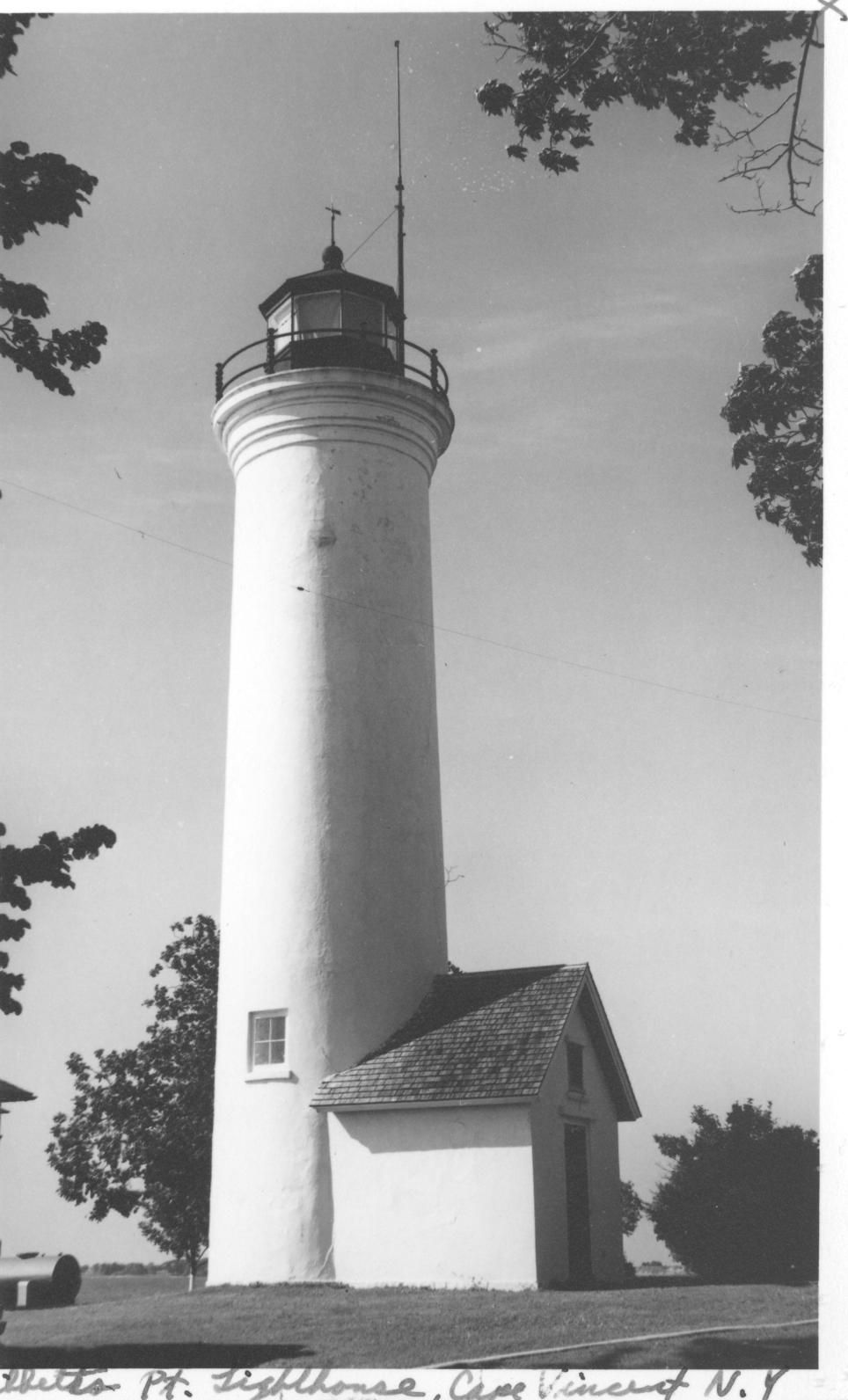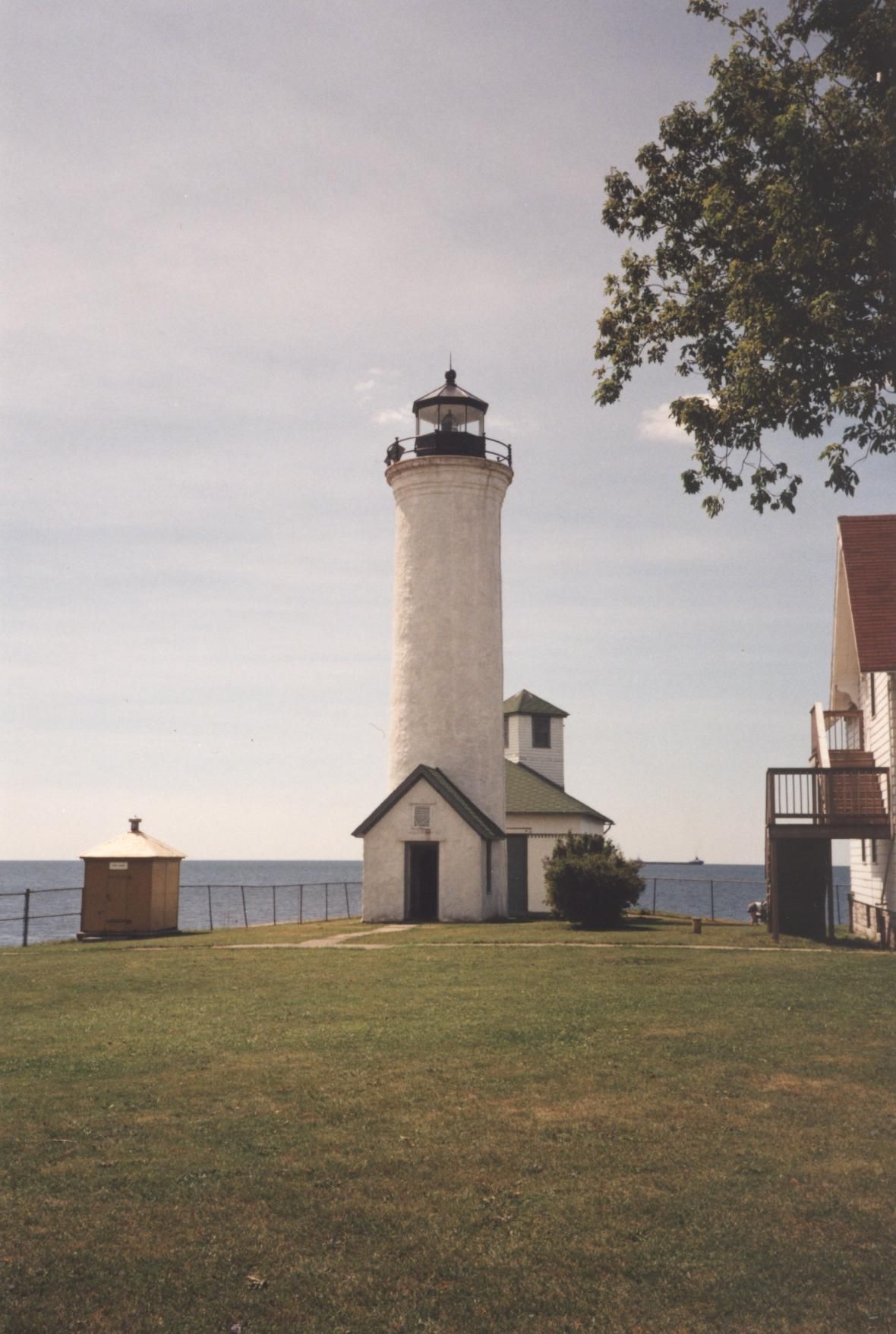The oldest of the lighthouses in the Thousand Islands, Tibbett’s Point was first built in 1827, and was so named because the 3-acre lighthouse site was once part of a 600-acre parcel of land granted to Capt. John Tibbett (or Tibbetts). West of Cape Vincent, NY, it is located where Lake Ontario empties into the St. Lawrence River, on the American side of the River.
The original structure was a 30-ft tall stone tower, which tapered from 18 feet in diameter at the base to 9 feet at the top. After several years of complaints and poor reports on its condition and efficiency, the tower was rebuilt in 1854, and that conical white stucco/brick tower remains standing today.

This history is consistent with the Act of 1851 that ordered an inquiry into the conditions of the lighthouse establishments of the country, including a detailed comparison with other countries. The resulting report of 1852 was highly critical, and the use of Fresnel lenses (which hugely improved the effectiveness of lighthouses from the previous lantern and reflector system) was strongly recommended to the Treasury Department. So in 1854, a new fourth-order Fresnel lens was installed at Tibbett’s Point and is today one of a dwindling number remaining in operation on the Great Lakes/St. Lawrence River.
The recurring story, of course, is the deterioration to which these lighthouses and associated structures were prone. In 1877, the annual report of the Light-house Board says:
“The buildings at this station are old, much decayed, and too small to afford proper accommodations for the keepers. This light is at the entrance to the Saint Lawrence River from Lake Ontario. It must always be an important aid to navigation, and should be rebuilt. It is recommended that an appropriation of $10,000 be made for rebuilding this station.”
This recommendation was repeated in the reports of the following two years, more specifically identifying problems with the light tower itself, not only the outbuildings:
“A new dwelling, as recommended by the board in its last annual report, is urgently needed, the present building being old and in bad repair. The tower is in such condition that it should be rebuilt. An appropriation of $10,500 is recommended for this work.”

Then, in 1880:
“This station needs entire renovation. The dwelling will be rebuilt during the present season. The tower needs repairing, and the shore near the station must have some protection. The estimated cost of the repairs is $3,426.50.”
In 1881:
“The dwelling was entirely rebuilt. The tower should be replaced by an iron one, at an estimated cost, including foundation, of $5,400. It is not too much dilapidated to admit of economical repair.”
It is notable that there was a push for iron lighthouse towers in the (American) Thousand Islands at this time, related to the ongoing expenses required for lighthouse upkeep. The lighthouses at Cross-over Island, Rock Island, and Sunken Rock were all rebuilt with iron towers in 1882. This did not happen at Tibbett’s Point, however, for reasons never spelled out in the government proceedings. Instead, in 1883:
“The brick-work of the tower was rebuilt above the parapet wall, the wall was lined with wood, the tower was provided with a new lantern, having a wooden deck covered with copper, and certain minor repairs were made.”
Similar repeated requests for funding followed, from 1890 to 1895, for a steam fog signal so that the location of the lighthouse could be “made known at all times and in all kinds of weather.” It finally went into operation in 1897.

Over the next century, there were other changes made at Tibbett’s Point, but the outward appearance of the light tower, the keeper’s dwelling, and the other buildings changed little. The foghorn was replaced by a diesel-powered air diaphone signal in 1927. The lighthouse was staffed by the Coast Guard until 1981. In 1984, the site was listed in the National Register of Historic Places, and as well, the lightkeeper’s house was re-opened as a youth hostel. A Tibbett’s Point Lighthouse Society was formed in 1988, taking on the care and restoration of the tower. A visitor center was added to the grounds in 1993.
Lightkeepers:

The list of lightkeepers is a long one, and one is somewhat murky. In this table, the head keepers are listed, but there were many known assistant keepers (omitted here for brevity), and undoubtedly others whose names are not known. [I again acknowledge and thank Thomas Tag for the information he shared regarding American lightkeepers.]
The Coast Guard assumed responsibility for the lighthouse in 1939, but civilian keepers continued until the retirement of Edward Sweet, after which the keepers were Coast Guard employees. The lightkeeper’s dwelling was abandoned in 1981, when the light was fully automated and the on-site keeper discontinued, but it remains an active aid to navigation, maintained by the Coast Guard.
Many of the stories behind these names are lost, but a few reach us today. Adam Cratsenberg was born in New York in April 1817. His name is on a gravestone at the Riverside Cemetery in Cape Vincent and his wife Esther is buried there (d. 1889), but Adam moved to live with one of his adult daughters in Chaumont, Jefferson County in 1900. When he died in 1901, aged 84, a funeral service was held in Cape Vincent. He was likely buried at the Riverside Cemetery, but there are no dates inscribed on the memorial stone so it remains uncertain.
Adam served in the Civil War, and lost an arm at the brutal battle of Cold Harbor (a bloody two-week clash that resulted in approximately 15,000 dead or wounded, and more captured or missing). Following the war, he was appointed lightkeeper at Tibbett’s Point, where he acted for twenty years. Many lightkeepers at this time were veterans, who were rewarded for their service with these positions. I have written about political interference in civil matters before – today’s antics are nothing new! Cratsenberg was reportedly a “staunch Republican,” who was apparently so worried that he would lose his position after Grover Cleveland was elected as President, that he decided to resign his position before he could be replaced by a Democratic appointee!
Following Adam Cratsenberg, the Montanas (father David and son William) between them served for over half a century. They were one of several examples in the Thousand Islands of families who cared for their lighthouse over two generations (the Gillespies at Wolfe Island, and the Roots at Grenadier Island are two other examples) or where the duty passed from husband to wife (the Diepolders at Rock Island, and the Crosses at Gananoque Narrows and Jackstraw Shoals lights).

Tibbett’s Point is well worth a visit. Access is easy, and visitors today will see a very complete site, with the light tower, keeper’s dwelling, fog signal, and an iron oil-house.
by Mary Alice Snetsinger
Mary Alice Snetsinger grew up in the United States and Canada, and worked for four years at Thousand Islands National Park. She became interested in the 19th century lighthouses of the Thousand Islands in 1997 and has been researching them ever since. Mary Alice provided TI Life with articles about 14 Thousand Islands Lighthouses. Be sure to see our two sets of articles: before 2019 and after 2019. What a wealth of history and interest. Also see more about Mary Alice Snetsinger, ecoserv@kos.net
Editor's Note: Our thanks to Mary Alice who never ceases to find interesting and unknown facts about these iconic lighthouses of the Thousand Islands! Right now she is researching the last one - but then this editor says... what will be next?
Also we appreciate that one of our reader, Steven Glazer, read this article and quickly had some revisions. That led to Steven and Mary Alice comparing their research and for that TI Life will benefit. We have added the new information to this article on, October 16, 2023 and we will add more if it becomes available.
[Header photo: Tibbett's Lighthouse and Point. Photo from the Ian Coristine Collection, © Photo Ian Coristine/1000IslandsPhotoArt.com.]
Posted in: Volume 18, Issue 10, October 2023, History, People, Places
Please click here if you are unable to post your comment.
